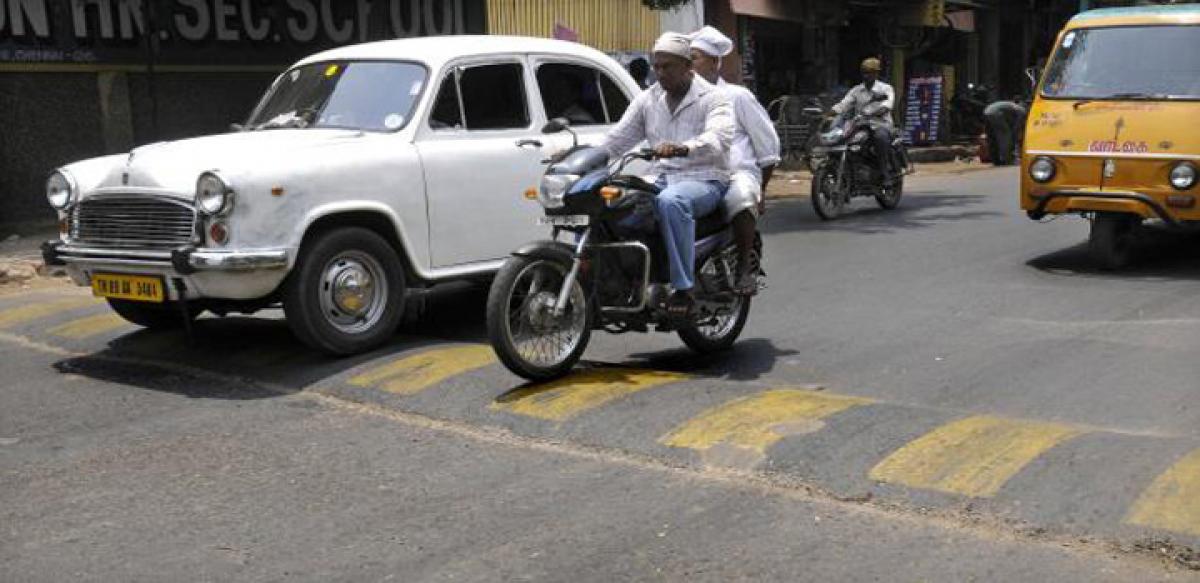Just In

Illegal and unscientific speed breakers in densely populated areas of the city are taking a toll on denizens. Officials of Greater Hyderabad Municipal Corporation and traffic police department claimed ignorance over the issue of jurisdiction by simply pointing a finger at each other, despite the fact that roads are laid and maintained by the civic body and the radium reflectors and radium paint on
Hyderabad: Illegal and unscientific speed breakers in densely populated areas of the city are taking a toll on denizens. Officials of Greater Hyderabad Municipal Corporation and traffic police department claimed ignorance over the issue of jurisdiction by simply pointing a finger at each other, despite the fact that roads are laid and maintained by the civic body and the radium reflectors and radium paint on most of these unscientific speed breakers are executed by the traffic department.
At several places, the height of these speed breakers is much above the Indian Road Congress (IRC) guidelines issued in 1987. The IRC had suggested speed breakers to be laid on minor roads which intersect with major roads and mid-block sections in urban areas where there is a tendency of accidents due to speeding and also near hospitals and schools. Several residential areas in the city have at least 10 speed breakers in a stretch of one km.
Areas that have the most unscientific and 'dangerous' speed breakers include Seetaphalmandi, Bagh Amberpet, Banjara Hills, Yakutpura, Azampura, Chanchalguda, Dabeerpura, Barkas, Salala, Madhavapuri, Yousufguda, A S Rao Nagar, Secunderabad, Vikrampuri, Hastinapuri, Tolichowki, Kukatpally Housing Board, Chandanagar, Mehdipatnam, Neredmet, Malkajgiri, Safilguda, Sainikpuri, Red Hills and Hill Fort Road.
According to Prof Krishna Rao, transportation engineering expert, most of the city speed breakers were constructed in violation of norms and are too steep, posing grave danger to road users. "Some of the speed breakers constructed by GHMC also do not adhere to the specifications of IRC," he said.
“These unscientific speed breakers result in water stagnation during the rainy season and also damage roads,” Rao said. "According to IRC guidelines, a speed breaker should be 10 cm high with a steep gradient and warning signs need to be placed 100 metres before the speed breaker on both sides. Also, white markings must be made on each speed breaker to warn commuters," he said.
GHMC engineering wing officials admitted that the issue never came up for discussion in any of their meetings over the past several years. They however admitted to the presence of more than 7,500 unauthorised speed breakers in the city. "It is the responsibility of denizens to make sure that they resist illegal speed breakers in their vicinity," he said.
Interestingly, GHMC officials gave several 'false' replies to information sought under RTI by The Hans India. When asked how many speed breakers were laid by GHMC to control speed in the city, Qutbullapur executive engineer Ram Prakash replied, “The number of speed breakers officially sanctioned can be taken from the concerned office of the DCP (traffic) as Additional Commissioner of Police (traffic) is the competent authority to issue permission for laying speed breakers."
To another question, "How many speed breakers were laid without proper specification and how many incidences came to your notice?" the answer was "Subject pertains to DCP (traffic)." To yet another question on whether there is an action plan to remove unauthorised speed breakers, if any, and when? The answer was "Subject pertains to DCP traffic."
The EE had repeated the same answer to all the queries filed in the RTI. Responding to queries, DCP traffic-II A V Ranganath said that their department was in no way connected with the issue of unauthorised speed breakers. He, however, said that of the 2,061 accidents reported in 2015, at least 40 per cent were due to illegal speed breakers.
"The number could increase at least by 30 per cent if accidents involving unscientific speed breakers are reported," he said. "The idea of putting up a 'hump' is to slow down the pace of a vehicle and not to damage the vehicle or cause injuries to the rider. Unauthorised speed breakers are not only endangering the lives of vehicle riders, but also resulting in severe spinal injuries," he added.

© 2024 Hyderabad Media House Limited/The Hans India. All rights reserved. Powered by hocalwire.com







